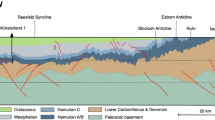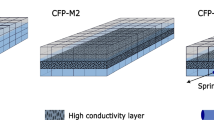Abstract
Four new thermal gradients have been determined for the Choogaryung Rift Valley. The thermal regime in the interior part of the Rift Valley is characterized by low temperature gradients in the range 16.2 to 17.3°C km−1. Disturbances of borehole temperature by drilling depend on the physical properties and rock type, drilling fluid, drilling rate, casing and depth of penetration. We calculated the effects of drilling fluid in the borehole through an integrated analysis of temperature and geological data for the formation temperature in the early stage after drilling. Compared to four boreholes drilled in connection with the intensive search for thermal regime between November 16 and 30 of 2000, holes in which temperature logs were obtained are plentiful. From an intense data set of temperature logs, formation temperature provides the opportunity for comparisons and calculations of geotherms. The temperature divergence due to drilling fluid at time t≥90 hours is negligible, while the result is shown as a valuable indicator for different time, t=40 hours. The temperature disturbance has been satisfactorily tested with the analytic calculations using heat conduction equation. With evidence for recent tectonothermal events the variations of the heat flow values in the study area can be mostly explained on the basis of heat conductivity of the crustal rock.
Similar content being viewed by others
References
Beck, A.E., 1976, An improved method of computing the thermal conductivity of fluid-filled sedimentary rocks. Geophyiscs, 41, 133–144.
Carslaw, H.S. and Jaeger, J.C., 1959, Conduction of heat in solids. Oxford University Press, Oxford, 510 p.
Espinosa, G., Garcia, A., Santoyo, E. and Hemandez, I., 2001, TEMLOPI/V.2: a computer program for estimation of fully transient temperatures in geothermal wells during circulation and shut-in. Computers & Geosciences, 27, 327–344.
Han, U., 1991, Global warming from borehole temperature evidence. Journal of the Korean Earth Science Society, 12, 93–99.
Korea Meteorological Administration, 2000, Monthly report of automatic weather station data. Korea Meteorological Administration, Seoul, 104 p.
Lee, C., Han, U. and Lee, S., 2000, Subsurface temperature perturbations due to surface temperature fluctuation at a site in the northeastern Seoul area. Journal of the Geological Society of Korea, 36, 325–334.
Lee, T., 1982, Estimation of formation temperature and thermal property from dissipation of heat generated by drilling. Geophysics, 47, 1577–1584.
Roy, S. and Rao, R.U.M., 1999, Geothermal investigations in the 1993 Latur earthquake area, Deccan volcanic province, India. Tectonophysics, 306, 237–252.
Author information
Authors and Affiliations
Corresponding author
Rights and permissions
About this article
Cite this article
Lee, CK., Han, U. Estimation of borehole temperature disturbed by drilling. Geosci J 5, 313–318 (2001). https://doi.org/10.1007/BF02912702
Received:
Accepted:
Issue Date:
DOI: https://doi.org/10.1007/BF02912702




